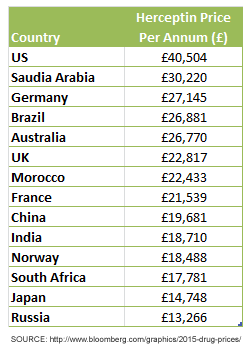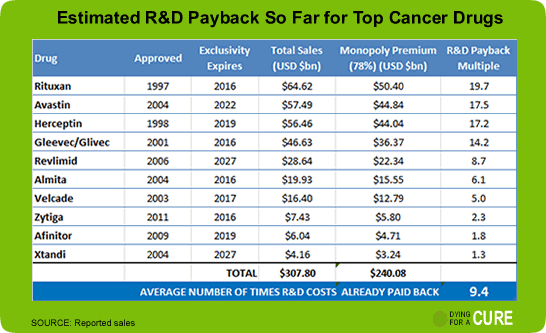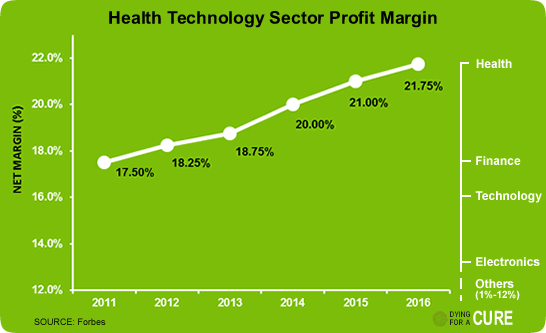Cancer Drugs Fund Was Short-Sighted
The Cancer Drugs Fund was put forward by David Cameron during the 2010 General Election campaign – a tempting olive branch for many cancer patients desperate to get access to expensive life-saving drugs but in reality a short-sighted, vote-winning gesture that has helped to make drugs even more unaffordable in the longer term.
If you are unlucky enough to get cancer you would hope that you would have access to the best available drugs via the NHS, but sadly this is increasingly not the case. Rising prices for new cancer drugs mean that a growing number are now too expensive for the NHS to provide and have become a luxury for the rich. In 2015 alone, the NHS withdrew 36 cancer treatments that were previously available and many more are expected to be discontinued in the next few months, despite the fact that the public has contributed to the costs of research and development for many of these drugs.
Birth of the Cancer Drugs Fund
Funding decisions for NHS drugs are made by NICE (the National Institute for Health and Care Excellence) based on a cost benefit analysis – drugs are only funded if they can extend lives at a cost of less than £30,000 per year, after taking into account the effects on quality of life, or £50,000 for end-of-life drugs. But many cancer drugs are being sold by drug companies for prices much higher than this.
Faced with the growing problem of life-saving cancer drugs being priced out of reach of patients, in 2010 David Cameron came up with the bright idea of creating a separate pot of money called the Cancer Drugs Fund. The idea was that cancer drugs would be given extra money, so that higher prices could be paid, thereby giving cancer patients to access many drugs that NICE had rejected as too expensive. Initially this extra pot of money was £200m per year but due to budget overuns it has now risen to £340m, bringing NHS England’s annual cancer drug bill to around £1.5bn. To try to bring the Cancer Drugs Fund under better control, responsibility for it now been transferred to NICE, which is expected to cull more drugs from the list when it reluanches the scheme in July 2016.
Cancer Drugs Fund Has Made Matters Worse
While the Cancer Drugs Fund may have been set up with compassionate intentions to help improve access to previously unaffordable drugs, in practice the attraction of additional money was clearly only going to encourage drug companies to raise prices even more over the longer term, making them even more unaffordable.
In 2014, the Financial Times attacked the whole idea of the Cancer Drugs Fund describing it as “a populist gesture that gives the impression of benefiting patients, but in fact rewards poor quality drugs while benefiting a handful of pharmaceutical companies at the expense of the taxpayer and the full range of NHS patients”.
 Many cancer drugs are only available from one supplier due to patent restrictions and there is clear evidence that drug companies abuse this monopoly over supply to simply charge whatever the market will bear.
Many cancer drugs are only available from one supplier due to patent restrictions and there is clear evidence that drug companies abuse this monopoly over supply to simply charge whatever the market will bear.
The table on the right shows how prices for the popular breast cancer drug Herceptin vary in different countries.
By raising the amount we are prepared to pay, we are just inviting further price increases to levels being charged in other countries with bigger budgets.
Drug Company Profits Soar
Meanwhile, while drugs are being priced out of reach of patients, drug company profits are soaring. The following table shows 2015 profit margins for the top 7 cancer drug companies, which control over 70% of all cancer drug sales worldwide. Average profit margins are 20.5%, with one company making a jaw-dropping 35.3% profit margin.

High profit margins are not a new thing either – the pharmaceutical industry is the most profitable in the world and profit margins have been rising steadily for years.
It is morally incomprehensible that profits are being made on this scale while life-saving drugs are being priced out of reach of patients who need them.
We Need to Treat the Causes of High Drug Prices not the Symptoms
It’s about time the Government woke up to the way in which cancer is being commercially exploited and cooperated with other countries to tackle this disease as a humanitarian crisis rather than allow it to be treated like a huge money-making opportunity for the privileged few.
The Cancer Drugs Fund was a short-sighted gesture that has further contributed to the problem of high drug prices it was set up to help with. Rather than simply pandering to the drug companies by finding extra money to fuel ever increasing prices, the Government should be looking at why prices are high in the first place.
Drug companies often try to justify their high prices by saying that the drugs are expensive to develop. This is true to an extent, drugs are expensive to develop, but high prices are being charged long after R&D costs have been paid back and the Government is doing nothing to prevent drug companies abusing their monopoly of supply. On average, drug prices fall by around 78% once patents expire, allowing competitors to make cheaper generic copies, so it should be possible for drug companies to lower prices substantially once R&D costs have been paid off.
The Tufts Center for the Study of Drug Development estimates that it costs on average $2.56bn to develop a new drug. This cost takes into account the fact at only 12% of drugs investigated make it to market and also includes the cost of financing the investment at a generous rate of 10.5%. Many consider this cost to be exaggerated and that actual R&D costs are significantly lower, but even using this highest estimate of the average cost to develop a new drug, R&D costs are being paid back many times over for some drugs.
The following table lists 10 popular cancer drugs and estimates how much revenue has been generated to pay back R&D costs on the assumption that drug prices fall by 78% when patents expire. On average R&D costs for these drugs have already been paid back more than 9 times over and it is still many years before monopolies for some of these drugs expire.

drug companies are clearly abusing the legal monopolies afforded to them under drug patents to profiteer from the desperation of patients clamouring for life-saving drugs
While there will inevitably be some overheads associated with spending the $2.56bn R&D cost, in an efficient business this should be a fractional cost not a multiple, so drug companies are clearly abusing the legal monopolies afforded to them under drug patents to profiteer from the desperation of patients clamouring for life-saving drugs.
This is what the UK Government needs to tackle to improve access to cancer drugs. It’s about time the Government woke up to the way in which cancer is being commercially exploited and cooperated with other countries to tackle this disease as a humanitarian crisis rather than allow it to be treated like a huge money-making opportunity for the privileged few.
The Government needs to stand up to the drug companies rather than simply writing them cheques every time they want more money and should urgently work on a longer term, more sustainable solution to cancer drug prices.
The Dying for a Cure campaign is calling on the UK Government to do just that – to make fundamental reforms to the way cancer drugs are developed and funded to prevent cancer being commercially exploited and deliver more affordable and effective treatments for patients.
Please sign the campaign’s petition to help stop profiteering from cancer.


